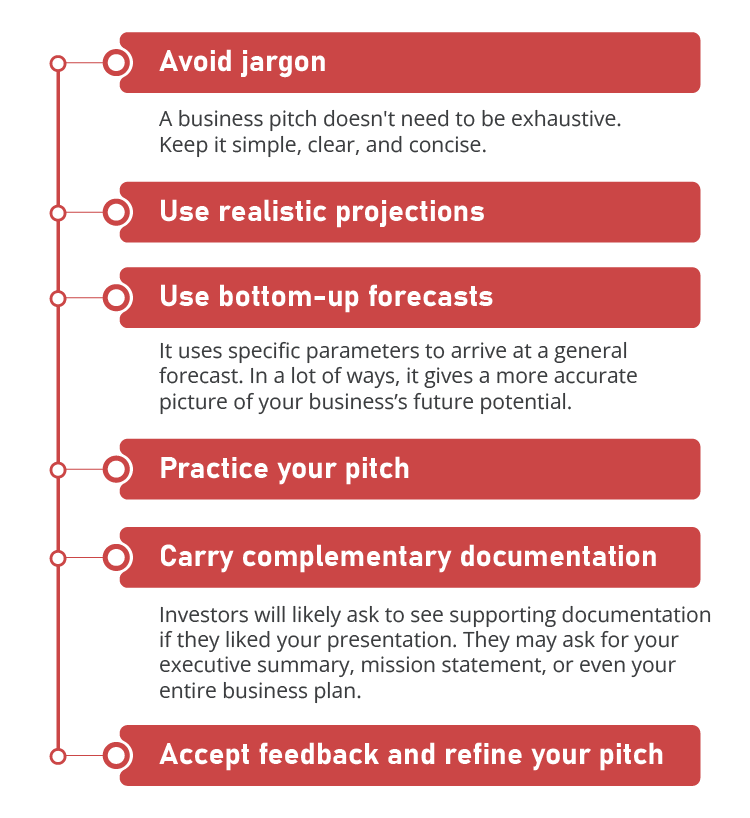Whether you’re a startup or an established company, raising capital is one of the hardest feats of entrepreneurship. Just having a viable business idea is not enough to score funding; you also need a great pitch to convey its viability.
In this article, we’ll see what is a business pitch, its different types, how to write one, and essential tips for writing a great pitch for your company.
What is a Business Pitch?
A business pitch is a short introductory document or speech you present to a prospective investor. It conveys the feasibility, profitability, and scope of your business idea. With it, you aim to persuade prospective investors to invest in your venture.
A business pitch should be clear, compelling, and catchy. It should focus on the value you create via the products or services you offer. Business pitches can be long or short, depending on the audience and the context it is presented in.
Types of Business Pitches
Although presenting your business idea in depth is ideal, investors might not always have enough time to go through the whole thing. That’s why you need to size your pitch depending on their availability.
Broadly speaking, there are three different types of business pitches:
1. The elevator pitch
The term elevator pitch comes from the idea that summarizing your pitch shouldn’t take longer than the duration of an elevator ride. That’s about 30 seconds to two minutes.
Within this short time window, you need to describe your product, the problem it solves, and why it’s worth investing in. The goal here is to pique the investor’s curiosity to know more, so you can get an appointment to elaborate on it later.
“The purpose of an elevator pitch is to describe a situation or solution so compelling that the person you’re with wants to hear more even after the elevator ride is over.” – Seth Godin
2. Short pitch
If an investor likes your elevator pitch and wants to hear more about your business idea, they might invite you for a quick meeting. This would be the time you cover all the essentials like your products, their USPs, your team, etc.
If the length of your pitch is between 5-10 minutes, it’s called a short pitch. If you’re taking part in a startup competition, your pitch should be no more than five minutes.
3. Long pitch
A long pitch, usually no longer than 20 minutes, provides a bigger picture and is your last chance to persuade an investor. It includes vital info about your company such as financial forecasts, sales, market share estimation, fund requests, etc.
If an investor has asked you to present your long pitch, it’s a good sign. It means your idea sparked their curiosity and they’re willing to fund you, but they need a final push to seal the deal.
How to Pitch your Idea to Investors
Going into a meeting with investors without proper preparation is a surefire way to get rejected. To stand a good chance at succeeding, there are a few things you need to do. Let’s see what they are.
1. Research the investors
A lot of entrepreneurs tend to pitch their idea to every investor they come across. However, you’re more likely to get funding if your idea resonates with their preferences.
That’s why it’s ideal to research your audience before creating a pitch.
Here are a few things to know about your prospective investors to tailor your pitch:
- Which industries do they usually invest in?
- Which geographical locations do they invest in?
- Do they invest in startups or established companies? What stages are they interested in?
- What is their average investment amount?
- Do their personal values match yours? Does their investment track record align with your company’s vision?
2. Create the presentation
A pitch deck is what you send to prospective investors prior to fixing an appointment. Its purpose is to pique their interest and outline what you will cover during your full presentation if given the chance.
A presentation deck is what you use during the full presentation of your idea. It acts as a visual representation of what you’ll be speaking about. When doing so, it’s recommended to follow the 10/20/30 rule by Guy Kawasaki. It’s a simple technique to make your presentation presentable.
According to it, your presentation:
- Should have a maximum of 10 slides
- Should be shorter than 20 minutes
- Shouldn’t have fonts smaller than 30 points
3. Organize sections
After you’ve pitched your offering, you need to present all the crucial details about your business idea. The goal here is to convey viability, profitability, and scalability.
These are the essentials every business pitch should have:
- Target customers
- Available market and target market sizes
- Marketing and sales plan
- Competitive analysis
- Product-market fit
- Financial plan
- Investment request
- Usage of the funds
- Team
4. Showcase personal values
When investors listen to your pitch, their primary focus is not just on your business idea but also on your personality. This is because a partnership is not only about profitability but also reliability. Investors look for certain qualities in you, your co-founders, and your team to access your company culture.
These are some of the ways they will analyze you and your team:
- What do you stand for as a person?
- How is your relationship with money?
- Do your skills complement your co-founders’ skills?
- How well do you accept feedback and criticism?
- Are your forecasts reasonable or exaggerated?
- Are you aware of and concerned about social issues?
5. Tell a story
Humans are wired to remember stories rather than facts. That’s why you should leave enough room for storytelling in your pitch instead of packing it with just facts and statistics. This helps provide your investors with perspective and a chance to engage with you on a personal level.
Once you have their attention, you can add credibility to your story and display competence via facts, statistics, charts, etc. This way, you address both the emotional and the analytical side of the investor.
“Your audience is waiting for your stories. They have memory slots tailor-made to light up and remember you.” – Steve Woodruff
6. Present a roadmap
To make your pitch stand out, present a roadmap of how you envision your business to grow. This will help investors see that you have a growth mindset and have planned ahead to scale your business.
You can convey this through the following:
- Present the goals you want to achieve in the coming years
- State your business risks and your strategy to offset them
- Mention your exit strategy
Tips for Creating a Business Pitch
1. Avoid jargon
A business pitch doesn’t need to be exhaustive. Keep it simple, clear, and concise. Unless specifically requested, don’t bother your prospective investors with the details they didn’t ask for. Also, try to limit your use of industry jargon and buzzwords as much as possible since doing that might fuel some misunderstanding.
2. Use realistic projections
Investors want to know how profitable your business is and how you’ll steer your business toward growth. You convey this via your financial projections.
Understandably, it’s tricky to make accurate predictions of future revenue and expenses. But you can still estimate and present realistic numbers based on past data and adequate research.
Many entrepreneurs underestimate expenses, but seasoned investors are quick to notice this. So make sure you’ve considered everything.
3. Use bottom-up forecasts
Estimating future financial performance often comes down to which method you use to get your numbers. While the top-down method is faster, easier, and makes for impressive numbers in pitch meetings, investors are well aware of its fallibility.
Conversely, the bottom-up market analysis method is slower and harder, but yields more concrete and reliable projections. It uses specific parameters to arrive at a general forecast. In a lot of ways, it gives a more accurate picture of your business’s future potential.
4. Practice your pitch
As we mentioned before, your presentation lasts only 20 minutes and it’s up to you to make the most of this time. So it’s important to practice as many times as necessary to ensure you’re using the time to get your point across accurately and not going off-topic.
5. Carry complementary documentation
If your presentation managed to charm the investors, they will likely ask to see supporting documentation. They may ask for your executive summary, mission statement, or even your entire business plan. Make sure you have these documents ready.
6. Accept feedback and refine your pitch
Regardless of the outcome of your presentation, if the investors have any suggestions, accept them with a positive attitude. If time permits, you can even ask for feedback voluntarily. This way, you’ll be able to refine your pitch for the next prospect.
Score funding with a business pitch
Selling your business idea is an art you need to master if you wish to scale your company. Create a pitch as per your needs to get your point across clearly and accurately. Follow the above steps and tips to create a compelling pitch to motivate investors to lock in their decision.












